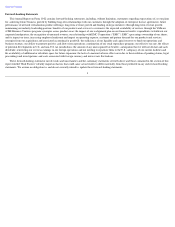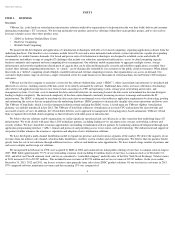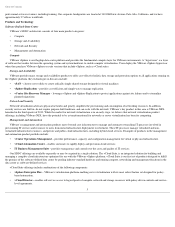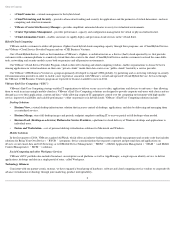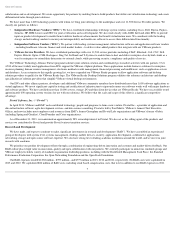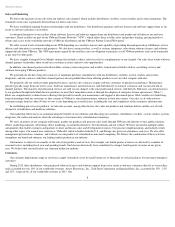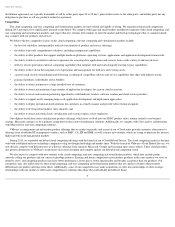VMware 2013 Annual Report Download - page 15
Download and view the complete annual report
Please find page 15 of the 2013 VMware annual report below. You can navigate through the pages in the report by either clicking on the pages listed below, or by using the keyword search tool below to find specific information within the annual report.
Table of Contents
As our vSphere-related products continue to mature, our future revenue growth is increasingly dependent on revenue from our new product and
technology offerings. Our newer initiatives may be less profitable than our established products, and we may not be successful enough in these newer
activities to recoup our investments in them. If any of these risks were to occur, it could damage our reputation, limit our growth and negatively affect our
operating results.
Our recently launched vCloud Hybrid Service offering relies upon a number of third-party providers for data center space, equipment, maintenance and
other colocation services, and the loss of, or problems with, one or more of these providers may impede the growth of our vCloud Hybrid Service
offerings, adversely impact our plans to expand the service and damage our reputation.
We recently launched our vCloud Hybrid Service cloud service offerings in 2013 in the United States and announced plans to expand the services
globally. Our vCloud Hybrid Service offerings rely upon third-party providers to supply data center space, equipment maintenance and other colocation
services. While we have entered into various agreements for the lease of data center space, equipment maintenance and other services, third parties could fail
to live up to the contractual obligations under those agreements. For example, a data center landlord may fail to adequately maintain its facilities or provide
an appropriate data center infrastructure for which it is responsible. If that were to happen, our ability to deliver services at levels acceptable to our customers
and at levels that we have committed to could be impaired. Additionally, if the third parties that we rely on do fail to deliver on their obligations, our
reputation could be damaged, our customers could lose confidence in us, and our ability to maintain and expand our vCloud Hybrid Service offerings would
be negatively impaired.
13
• Our increasing focus on developing and marketing IT management and automation and IaaS (including software-defined networking and vCloud
Hybrid Services), offerings that enable customers to transform their IT systems will require a greater focus on marketing and selling product suites
and more holistic solutions, rather than selling on a product-by-product basis. Consequently, we will need to develop new strategies for marketing
and selling our offerings, our customers’ purchasing decisions may become more complex and require additional levels of approval and the duration
of sales cycles for our offerings may increase.
• We will need to develop appropriate pricing strategies for our new product initiatives. For example, it has frequently been challenging for software
companies to derive significant revenue streams from open source projects, such as certain of our offerings. Additionally, in some cases our new
product initiatives are predicated on converting free and trial users to paying customers of the premium tiers of these services, and therefore we must
maintain a sufficient conversion ratio for such services to be profitable. Also, certain of our new product initiatives have a subscription model. We
may not be able to accurately predict subscription renewal rates or their impact on results, and because revenue is recognized for our services over
the term of the subscription, downturns or upturns in sales may not be immediately reflected in our results.
• The success of vCloud Hybrid Service will be dependent on the final global implementation of the offering and building successful go-to-market
strategies. We will need to build sales expertise and infrastructure to support the new offering. This hybrid cloud offering involves significant risk
and may not be accepted by customers. Further, this offering may lead our team to reduce the time spent on selling our existing product portfolio,
which could have a material negative impact on revenues.
• Our new products and services may compete with offerings from companies who are members of our developer and technology partner ecosystem.
Consequently, we may find it more difficult to continue to work together productively on other projects, and the advantages we derive from our
ecosystem could diminish.
• The cloud computing and virtualized end-user computing industries are in early stages of development. Other companies seeking to enter and
develop competing standards for the cloud computing market, such as Microsoft, IBM, Oracle, Google, Amazon and Cisco, and the end-user
computing market, such as Citrix and Microsoft, have introduced or are likely to introduce their own initiatives that may compete with or not be
compatible with our cloud and end-user computing initiatives which could limit the degree to which other vendors develop products and services
around our offerings and end users adopt our platforms.
• Emerging IT sectors, such as those within IaaS, are frequently subject to a “first mover” effect pursuant to which certain product and service
offerings can rapidly capture a significant portion of market share and developer attention. Therefore, if competitive product and service offerings in
these sectors gain broad adoption before ours, it may be difficult for us to displace such offerings regardless of the comparative technical merit,
efficacy or cost of our products and services.
• Developing and launching new technologies in new markets, as we are doing with our VMware NSX virtual networking, vSAN virtual storage and
vCloud Hybrid Service initiatives, requires significant investments of resources and often entails greater risk than incremental investments in
existing markets. If these investments are not successful, our rate of growth may decline or reverse and our operating results will be negatively
affected.


